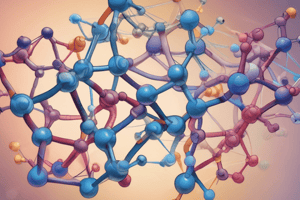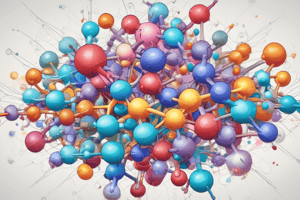Podcast
Questions and Answers
Which amino acid is known as the 21st amino acid in eukaryotes?
Which amino acid is known as the 21st amino acid in eukaryotes?
- Glutamine
- Selenocysteine (correct)
- Valine
- Tyrosine
All amino acids possess an L-configuration.
All amino acids possess an L-configuration.
True (A)
What are the two main types of functional groups present in amino acids?
What are the two main types of functional groups present in amino acids?
α-amino group and α-carboxyl group
Essential amino acids cannot be __________ in mammals.
Essential amino acids cannot be __________ in mammals.
Match the following amino acid types with their characteristics:
Match the following amino acid types with their characteristics:
Which represents the point where the net charge of an amino acid is zero?
Which represents the point where the net charge of an amino acid is zero?
In an acidic environment, the pH level is high and there are fewer H+ ions in the medium.
In an acidic environment, the pH level is high and there are fewer H+ ions in the medium.
What are the abbreviations used for amino acids called?
What are the abbreviations used for amino acids called?
What is one of the primary functions of proteins?
What is one of the primary functions of proteins?
Proteins are primarily composed of nucleotides.
Proteins are primarily composed of nucleotides.
What is the role of hemoglobin in the body?
What is the role of hemoglobin in the body?
Amino acids consist of a central carbon atom, an amino group, a carboxylic acid group, and a ________ group.
Amino acids consist of a central carbon atom, an amino group, a carboxylic acid group, and a ________ group.
Match the types of protein functions with their descriptions:
Match the types of protein functions with their descriptions:
Which structure is considered the simplest form of protein structure?
Which structure is considered the simplest form of protein structure?
What happens during protein denaturation?
What happens during protein denaturation?
There are fewer than 100 amino acids found in nature.
There are fewer than 100 amino acids found in nature.
Which of the following structures involves local hydrogen bonds between amino acids?
Which of the following structures involves local hydrogen bonds between amino acids?
The primary structure of a protein changes after denaturation.
The primary structure of a protein changes after denaturation.
What type of bond is formed between two cysteine residues?
What type of bond is formed between two cysteine residues?
During peptide bond formation, one molecule of _____ is released.
During peptide bond formation, one molecule of _____ is released.
Match the types of protein structure with their features:
Match the types of protein structure with their features:
Which of the following factors does NOT cause denaturation?
Which of the following factors does NOT cause denaturation?
In quaternary structure, proteins always consist of identical subunits.
In quaternary structure, proteins always consist of identical subunits.
What is the term for the process of regaining the natural form of a protein after denaturation?
What is the term for the process of regaining the natural form of a protein after denaturation?
Flashcards
Proteinogenic amino acids
Proteinogenic amino acids
The 20 amino acids directly coded by DNA and used to build proteins.
Selenocysteine
Selenocysteine
A 21st amino acid used in eukaryotes for protein synthesis.
L-conformation
L-conformation
The specific three-dimensional arrangement of amino acids in proteins.
Amino acid mutation
Amino acid mutation
Signup and view all the flashcards
Phosphorylation
Phosphorylation
Signup and view all the flashcards
Essential amino acids
Essential amino acids
Signup and view all the flashcards
Amphoteric molecules
Amphoteric molecules
Signup and view all the flashcards
Isoelectric point
Isoelectric point
Signup and view all the flashcards
Primary Structure
Primary Structure
Signup and view all the flashcards
Peptide Bond
Peptide Bond
Signup and view all the flashcards
Secondary Structure
Secondary Structure
Signup and view all the flashcards
Tertiary Structure
Tertiary Structure
Signup and view all the flashcards
Disulfide Bonds
Disulfide Bonds
Signup and view all the flashcards
Quaternary Structure
Quaternary Structure
Signup and view all the flashcards
Denaturation
Denaturation
Signup and view all the flashcards
Denaturing Agents
Denaturing Agents
Signup and view all the flashcards
Renaturation
Renaturation
Signup and view all the flashcards
Protein Functions
Protein Functions
Signup and view all the flashcards
Amino Acid Structure
Amino Acid Structure
Signup and view all the flashcards
Amino Acid Types
Amino Acid Types
Signup and view all the flashcards
Protein Structure
Protein Structure
Signup and view all the flashcards
Study Notes
Amino Acids and Protein Structure
- Proteins are biomacromolecules made of amino acids.
- Proteins perform many crucial functions.
- Learning objectives for biochemistry course include listing protein functions, describing amino acid structure, calculating isoelectric point, recognizing protein structures, and explaining protein denaturation.
Learning Objectives
- List the functions of proteins.
- Describe amino acid structure.
- Calculate isoelectric points.
- Recognize the primary, secondary, tertiary, and quaternary structures in proteins.
- Explain protein denaturation.
Proteins
- Proteins are biomacromolecules composed of amino acids.
- They are responsible for various essential functions.
Protein Functions
- Catalysis (Enzymes): Increase the reaction rate of metabolic chemical reactions by decreasing activation energy.
- Transport: Transport molecules throughout the circulatory system or between cellular compartments (e.g., hemoglobin transports oxygen).
- Signalling: Hormones direct and regulate metabolism in the body. Receptors receive signals and play a role in cellular response.
- Structural Elements: Provide support and shape to cells and tissues (e.g., cytoskeleton, hair, nails).
Amino Acids
- Amino acids have a common structure with an amino group, a carboxyl group, a central carbon atom (alpha carbon), and a variable side chain (R group).
- Twenty standard amino acids are commonly found in proteins.
- Twenty-one possible amino acids.
- Different side chains create diverse properties among amino acids.
- Essential amino acids cannot be synthesized in the body and must be obtained from food.
- The 20 most common amino acids in proteins are directly encoded by DNA.
- Other amino acids can also be utilized.
- Amino acids are amphoteric, acting as both a base and an acid.
- The properties of amino acids are pH dependent; the charge of side chains change depending on the pH.
- The isoelectric point (pI) is the pH at which the amino acid has a zero net charge.
Protein Structure
- Proteins have different levels of structure.
- Primary: The linear sequence of amino acids.
- Secondary: Local folding patterns like α-helices and β-sheets stabilized by hydrogen bonding.
- Tertiary: The overall 3D structure of a single polypeptide chain stabilized by diverse interactions among amino acid side chains, including hydrogen bonds, hydrophobic interactions, ionic bonds, and disulfide bridges.
- Quaternary: The arrangement of multiple polypeptide chains into a larger functional unit and the formation of hetero or homodimers, homotrimers/tetramers, etc.
- Ribosomes are responsible for protein's 3D construction.
Peptide Bond
- Peptide bonds form between amino acids during protein synthesis.
- One molecule of water is released during this bond formation making it a dehydration reaction.
- Peptide bonds link amino acids in a specific linear sequence defining the primary structure of a protein, and they are preserved even after protein denaturation.
Denaturation
- Denaturation disrupts the secondary, tertiary, and sometimes quaternary structures of a protein.
- Primary structure (peptide bonds) remains intact.
- Denaturation results in a loss of biological activity.
- Factors that cause denaturation include high temperatures, changes in pH, organic solvents, and certain chemical agents.
Renaturation
- Proteins can sometimes regain their natural shape (native conformation) after denaturation under specific conditions.
Studying That Suits You
Use AI to generate personalized quizzes and flashcards to suit your learning preferences.




